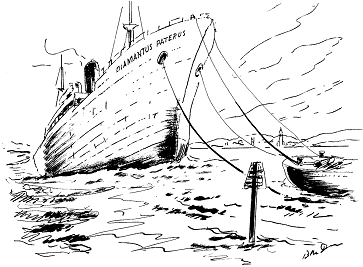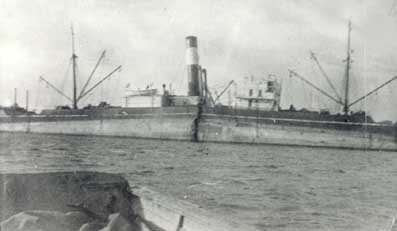END OF A SHIP AT SLIGO
By Captain Frank Devaney
The Diamantis Pateras was a typical three island tramp steamer of her day. She was
built at Stockton-on-Tees in 1905 as the Arosa, was later renamed Grelrosa, and when
finally purchased by Mr. D. J. Pateras of Greece, he gave her the name Diamantis Pateras
and registered her on the island of Chios.
Her length was 331 feet, beam 47 feet 5 inches, Gross Tonnage 2,794 and Net Tonnage
1,722 tons.
She arrived in Sligo Bay on February 22 1925, loaded with grain from the River Plate,
and during a westerly gale she managed to get both her sea and river pilots, Jack Herity
and Redmond Bruen onboard, but due to the weather she steamed out head to sea and missed
that evening tide. During the night the wind veered northerly and moderated somewhat,
enabling her to anchor at the Wheaten Rock in the early morning of the 23rd.
 Having a draught of 20 feet 3
inches she was to go direct to the Deep Water Berth as the tides were beginning to cut,
that morning tide would have been used to avoid delay and lighterage at the Rosses Point
Buoys. As high water at Sligo occurs at about 6pm and 6am on the Spring Tides these deep
draughted vessels had to navigate in darkness during the winter months.
Having a draught of 20 feet 3
inches she was to go direct to the Deep Water Berth as the tides were beginning to cut,
that morning tide would have been used to avoid delay and lighterage at the Rosses Point
Buoys. As high water at Sligo occurs at about 6pm and 6am on the Spring Tides these deep
draughted vessels had to navigate in darkness during the winter months.
Unfortunately, due to the bad communications which existed at the time, the pilots were
unaware that the boatman was unable to light the oil lamps on the six leading river
perches the night before, owing to the bad weather.
Vessels of this class were low-powered, with a speed of about eight knots when loaded,
and were often very slow to answer the helm, especially when having only a few feet of
water under the keel, and as there were no tugs available at Sligo, piloting these vessels
must have been a nightmare.
At 05.40 hours the Diamantis Pateras hove up her anchor for what turned out to be the
last time ever and proceeded slowly inwards. After crossing the Bar and Bungar Bank
safely, Pilot Bruen took over from Pilot Herity off the Dead Man's Point.
With a strong northerly wind, and snow squalls becoming more frequent, she passed the
Metal Man and Rosses Point, and it must have become obvious that there were no lights on
the perches. In those days, before rural electrification, it was obviously a grim scene
indeed.
Rounding the Blennick on her starboard helm, she was steering poorly and had to be
given full steam for a while to make her answer more quickly. Then a heavy snow squall
blotted out visibility and the Pilot was working blind. She was soon approaching the Seal
Bank's northern tip off Ballyweelin, and as she had got too far to the south she got stuck
on this amidships, with deeper water under her for and after parts.
 When
the tide ebbed the hull was unable to take the strain and she broke her back. With that
the Captain rushed for the Pilot shouting: "You stick my ship, I stick you." He
was restrained and the Pilot was then taken ashore for his own safety. At a subsequent
enquiry held by the Sligo Harbour Commissioners and other interested parties, he was
justifiably exonerated from all blame.
When
the tide ebbed the hull was unable to take the strain and she broke her back. With that
the Captain rushed for the Pilot shouting: "You stick my ship, I stick you." He
was restrained and the Pilot was then taken ashore for his own safety. At a subsequent
enquiry held by the Sligo Harbour Commissioners and other interested parties, he was
justifiably exonerated from all blame.
The cargo was eventually taken to Sligo Quays by means of lighters and a Belfast
salvage company, McCauslands, arrived soon afterwards with their small vessels; Milewater
and St. Anthony, and having made the halves of the wreck buoyant, they towed them onto the
shingle beach at Ballyweelin, where breaking up operations commenced.
Some steel girders and railings belonging to the wreck were used in the building of a
new landing stage under the Elsinore Hotel at Rosses Point, and were to be seen until they
were covered over by the promenade which was built in recent years.
A table from her saloon is the one which you rest your glass on in "Austie's
Nautical Museum Bar", and one of her forecastle head ladders, is in Miss Katie
Haren's barn on Coney Island. They are all that remain today of the ill-fated vessel.

 Having a draught of 20 feet 3
inches she was to go direct to the Deep Water Berth as the tides were beginning to cut,
that morning tide would have been used to avoid delay and lighterage at the Rosses Point
Buoys. As high water at Sligo occurs at about 6pm and 6am on the Spring Tides these deep
draughted vessels had to navigate in darkness during the winter months.
Having a draught of 20 feet 3
inches she was to go direct to the Deep Water Berth as the tides were beginning to cut,
that morning tide would have been used to avoid delay and lighterage at the Rosses Point
Buoys. As high water at Sligo occurs at about 6pm and 6am on the Spring Tides these deep
draughted vessels had to navigate in darkness during the winter months.  When
the tide ebbed the hull was unable to take the strain and she broke her back. With that
the Captain rushed for the Pilot shouting: "You stick my ship, I stick you." He
was restrained and the Pilot was then taken ashore for his own safety. At a subsequent
enquiry held by the Sligo Harbour Commissioners and other interested parties, he was
justifiably exonerated from all blame.
When
the tide ebbed the hull was unable to take the strain and she broke her back. With that
the Captain rushed for the Pilot shouting: "You stick my ship, I stick you." He
was restrained and the Pilot was then taken ashore for his own safety. At a subsequent
enquiry held by the Sligo Harbour Commissioners and other interested parties, he was
justifiably exonerated from all blame. 